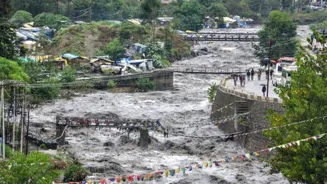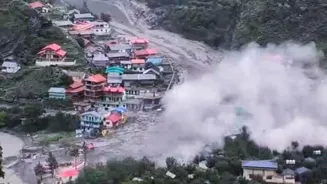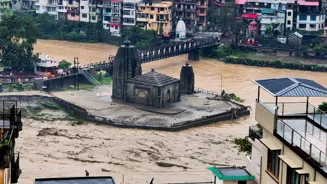While Uttarakhand is facing yet another flood, the Ministry of Home Affairs (MHA) data has revealed that at least 1,626 people have lost their lives this year due to heavy rain and lightning across India.
According to a reply tabled in the Rajya Sabha by the Ministry of Home Affairs on August 6, the figure, labelled ‘provisional’, is a strong reminder of India’s growing vulnerability to climate-related disasters. One of the worst-hit states, Uttarakhand, has already seen deaths of 71 people, alongside 67 animal deaths and damage to 9.47 hectares of crops till July. The Ministry confirmed that it does not centrally maintain data on such disasters but relies on states to report figures — a decentralisation approach that some experts say limits coordinated national response. “The primary responsibility for disaster management, including disbursal of relief assistance on ground level, rests with the State Governments concerned,” the minister added, referencing the National Policy on Disaster Management.
Uttarkashi faces devastation from catastrophic cloudbursts, with five confirmed dead and over 100 reportedly missing@AnchorAnandN shares more details
#Uttarkashi #Uttarakhand #uttarkashicloudburst #TheRightStand pic.twitter.com/H6LkqZeQ5r
— News18 (@CNNnews18) August 6, 2025
The Broader National Picture
Apart from Uttarakhand, several states have witnessed unusually high toll. As per data presented in the Rajya Sabha on August 6, 2025, the top five states with the highest number of human deaths due to hydro-meteorological disasters this year are Andhra Pradesh (343 deaths), Madhya Pradesh (243), Himachal Pradesh (195), Karnataka (102), and Bihar (101). These states account for over 60% of the total 1,626 reported fatalities nationwide, underscoring the widespread impact of extreme weather across diverse geographies.
The high tollreflects not only the intensity of this year’s monsoon but also the need for stronger early warning systems, community preparedness, and climate-resilient infrastructure in vulnerable regions.
In addition to the devastating human toll, the 2025 monsoon has also resulted in the loss of over 52,000 animals across India, reflecting the severe impact on rural livelihoods and agrarian communities. According to official data, Himachal Pradesh reported the highest number of animal deaths at 23,992, followed by Assam (14,269) and Jammu & Kashmir (11,067). Other states like Madhya Pradesh (1,625) and Gujarat (698) also recorded significant livestock losses.
#UttarakhandFlashFlood | Cloudburst or unchecked development? What really caused the devastating flash floods in #Uttarakhand that swept away homes and hotels? Rescue ops still underway, many feared trapped@ShivaniGupta_5 explains | #PlainSpeak #UttarkashiFlashFlood pic.twitter.com/t2Tv8Gmz3Q
— News18 (@CNNnews18) August 6, 2025
Is the warning system working?
When asked whether the public is receiving sufficient lightning and storm warnings, the government denied any major gaps.
According to the Ministry, “India Meteorological Department (IMD) has established a comprehensive system for the seamless monitoring, forecasting, and dissemination of warnings for thunderstorm and lightning hazards.”
The IMD reportedly operates a 102-sensor ground-based lightning detection network and offers a mobile app called DAMINI, which provides real-time alerts for lightning strikes within a 20-40 sq km radius.
Furthermore, the government stated, “IMD issues thunderstorm and lightning warnings up to 5 days in advance… These forecasts are provided in multi-hazard color-coded formats at the meteorological sub-division and district levels.”
Still, people argue that while the systems exist, implementation on the ground remains inconsistent, especially in rural or remote areas where phone connectivity and public awareness are lacking. The government also noted that it has approved a ‘Mitigation Project on Lightning Safety’ with a budget of Rs 186.78 crore for 50 lightning-prone districts across ten states. However, Uttarakhand is not on the list.














